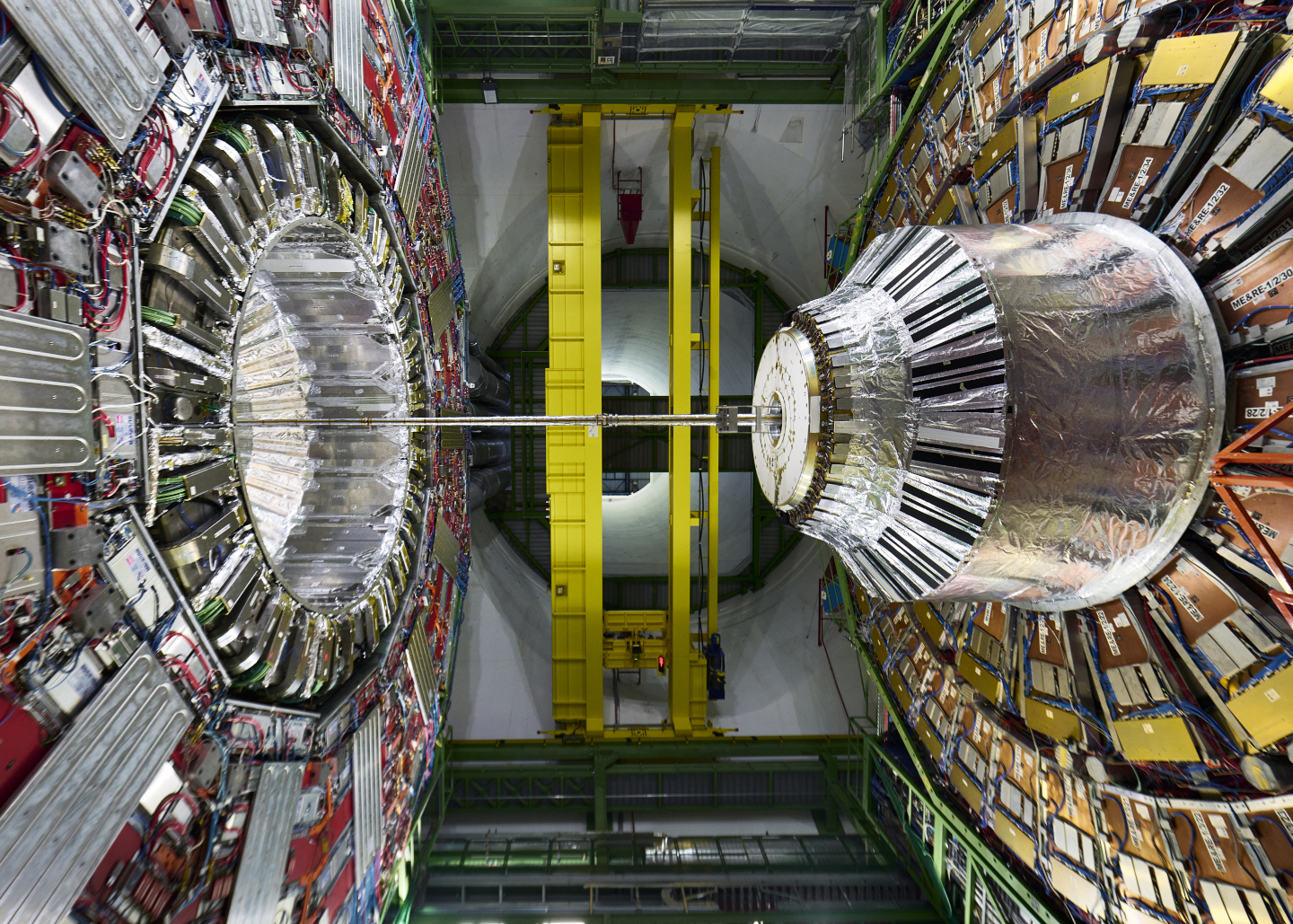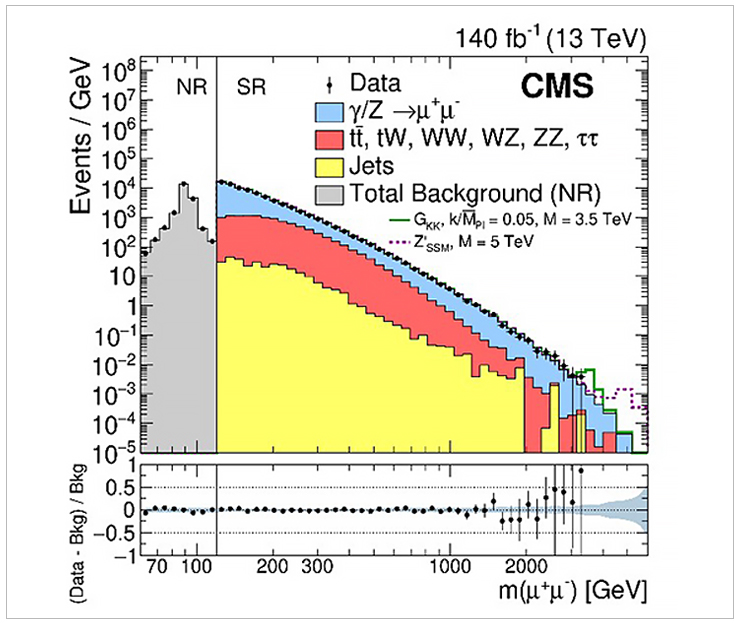JINR in CMS: from idea to experimental data
News, 27 December 2022
A series of papers “Test of the Standard Model and search for new physics in the Dimuon Final State with the CMS experiment at the Large Hadron Collider” authored by I. Golutvin, A. Zarubin, V. Zykunov, V. Karjavin, V. Korenkov, A. Lanyov, V. Matveev, V. Palchik, M. Savina, S. Shmatov А. received the JINR Encouraging Prize 2021. The series consists of 34 papers. Specialists continue working on all the directions announced in the series during RUN3 at the LHC (2022 – 2025).
Scientists of the Joint Institute stand at the origins of the CMS (Compact Muon Solenoid) experiment at the Large Hadron Collider at CERN. One of the ideologists of the CMS project is a chief researcher of the Laboratory of High Energy Physics Igor Golutvin. Not only JINR researchers have proposed a physical idea, but they have also created the key equipment of the facility. They also actively take part in the processing and analysis of experimental data.
CMS (Compact Muon Solenoid) is a detector aimed at identifying dimuon decay, i.e. decay into two muons. The CMS experiment was aimed at discovering the Higgs boson, in particular, by its decay into two Z bosons. In turn, each of the Z bosons decays into 2 leptons. Therefore, the registration of two pairs of muons is a typical signal of the Higgs boson production. The name of the experiment speaks for itself: the muon system is one of the main subsystems of the facility. It consists of three types of chambers: proportional cathode strip chambers (CSCs), drift tube chambers (DTs), and fast resistive plate chambers (RPCs). JINR scientists proposed the concept and created the first type of the chambers.
Head of the VBLHEP Scientific and Experimental Physics Department at the CMS Vladimir Karjavin , one of the participants in the experiments, spoke about the creation of detectors for the CMS experiment. Specialists started to develop prototypes in 1994. They created the first of them quite fast and tested it at CERN in the same year. The prototype was only 0.5 x 0.5 metres in size, but it demonstrated impressive accuracy. Its spatial resolution measured in a high-energy muon beam was 50 µm. It confirmed the right choice of the technology of CSCs. To optimise the design and characteristics of the detectors, specialists created several prototypes and conducted a large amount of methodological research, including tests of the chamber operation at charged particle beams under experimental conditions close to real ones. The research work resulted in the creation of a pre-production prototype with characteristics that fully meet the requirements of the CMS experiment.
In 2001, specialists started to produce 72 six-layer cathode strip chambers. JINR employees constructed a site with the equipment and control systems necessary for all stages of the creation of detectors. In 2003, specialists completed the production of chambers. They were delivered to CERN and installed in the CMS experimental facility. Together with detectors, specialists developed systems to ensure their operation: the supply of the working gas mixture, cooling of electronics, low-voltage and high-voltage power supply. In September 2008, experts completed the CMS assembly in the underground experimental hall. They checked the performance of all the systems of the facility and prepared it for operation. The first stage of collecting the experimental data at the LHC took place from 18 March 2010 to 17 December 2012.
The most striking result was, of course, the discovery of the Higgs boson. For the first time, the event of the paired production of Z bosons – a candidate for Higgs bosons – was registered on 24 September 2010. “At the same time, one of the muons was almost always registered by detectors created at JINR. Dubna data recording equipment provided the highest accuracy of coordinate recovery of tracks. For that reason, the accuracy of measuring muon pulses was about 1%,” Vladimir Karjavin emphasised.
During the run, electronics undergo high radiation loads, which means that by the end of it, it was already working at the limit of its capacities. Therefore, before the second run, scientists upgraded the detector and installed more radiation-resistant electronics with increased operating speed at its internal parts, just where cathode strip chambers operate. In addition, during the shutdown mode of the collider, JINR specialists also upgraded the chambers to improve the accuracy of the work. Thus, they increased the number of electronic channels and disconnected the strips. Afterwards, detectors started operating over the whole area with equally high accuracy.
After the second stage of data collection, scientists conducted one more cycle of equipment modernisation. This time, they increased the accuracy of all CMS chambers installed at the internal endcap detectors , i.e. detectors located close to the beam.
Despite the fact that the search for the Higgs boson was a flagship task and CMS detector systems were created to register muons formed primarily as a result of its decay, collaboration participants understood that the capabilities of the Large Hadron Collider are much greater. It allows specialists not only to study the Higgs boson mass region, but also to conduct constant scanning of mass states up to several TeV, i.e. to search for new physics in a wide range of values of invariant masses of muon pairs. There was a question: is it possible to measure such states and how to do it effectively? Scientists were looking for ways to use the already existing facility, muon chambers in particular, to register new states. During the discussions, they came up with an idea to use a process well-known to physicists for a long time, i.e. the production of muon pairs in the Drell-Yang process. When two quarks collide, two muons are formed. Muons are always a pure experimental signal, the background is practically absent. This means that if there is something unusual at the moment of the formation of two muons, scientists will definitely see and register it.
Thus, two directions of work on CMS appeared. The first one was precision measurements of the Drell—Yang process (cross sections, angular characteristics, etc.), which provide verification of the predictions of the Standard Model. They required a precision detector system, a theoretical understanding of this process, as well as computer support and a data processing system. “In general, the experiment managed to solve these problems,” Sergei Shmatov, Head of the CMS New Physics Sector at VBLHEP , highlighted. “It is especially valuable that they were solved at our Institute.” The second direction was the interpretation of data and the direct search for new physics. Specialists are still conducting such research, in which Dubna physicists play a leading role. The scientific team of the experiment is trying to understand what scenarios exist beyond the Standard Model, and what they predict. As it turned out, many scenarios of new physics predict the existence of new particles that eventually decay into a pair of muons. JINR physicists focus their efforts on the search for such processes.
The authors of the series of papers that received the JINR Prize described in more detail the history of the experiment at the LHC and the contribution of Dubna physicists to its development.
Tests of the Standard Model and Searches for New Physics in the Dimuon Final State with the CMS Experiment at the LHC
Systematic studies of high-energy muon pairs in the CMS experiment were initiated by JINR physicists in 2002. The proposed approach for studying physics processes with muons of large transverse momenta pT in the final state covers the entire spectrum of possible problems arising in solving such tasks, from theoretical calculations to complex analysis of experimental data. More narrowly, this problem was formulated as a study of the production of pairs of opposite-signed muons with large invariant masses (heavy dimuons) to test the SM predictions in a new energy range and searches for signals from new physics based on possible deviations from its predictions (Fig. 1). This direction of the CMS physics programme has become one of the priorities for scientists of RDMS (the collaboration of the institutes of Russia and JINR in CMS, Russia and Dubna Member States) from JINR.
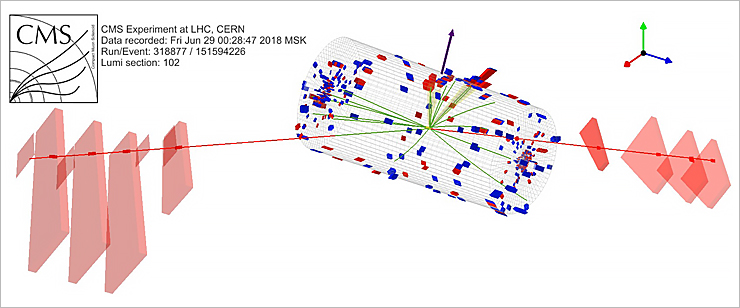 Fig. 1. Production of a pair of muons µ+µ− with the largest invariant mass m=3.3 TeV/c2, from the 2018 data
Fig. 1. Production of a pair of muons µ+µ− with the largest invariant mass m=3.3 TeV/c2, from the 2018 data
For the first time, the muon pair production with large invariant masses in hadron collisions were observed in the late 1960s in experiments at the AGS synchrotron (Brookhaven National Laboratory, USA), aimed at searching for the mediators of the weak interactions. A theoretical description of this process was suggested independently by S. Drell and T.-M. Yan and V. A. Matveev, R. M. Muradyan, and A. N. Tavkhelidze. Subsequently, this mechanism, widely known as the Drell – Yan mechanism, was studied in detail in various experiments. This process is extremely important for the physics of hadron colliders, since the measurement of its characteristics is a critical test of the Standard Model, including in a new energy range. The experiments at the LHC make it possible to study the production of lepton pairs in the region of invariant masses up to several TeV, i.e., for the first time, to go beyond the TeV scale of interactions (Fig. 2). In addition to tasks related to verification of SM predictions, this process has been used for several decades as an important tool for searching for signals of new physics.
One of the priorities of modern particle physics is the search for deviations from the SM predictions. Such deviations in a channel with a pair of leptons can serve as a sign of new physics, for example, production of new neutral gauge bosons Z′ from models of the Grand Unification (GUT), Kaluza-Klein (KK) graviton states in scenarios of multidimensional gravity with a reduced interaction scale, or candidates for dark matter (DM) particles. In addition, this channel is sensitive to the existence of new light Higgs states predicted in models with a non-minimal construction of the Higgs sector with two doublets and one singlet of Higgs fields, 2HDM+S (in particular, in the non-minimal supersymmetric NMSSM model, as a particular case of 2HDM+S) and in other more extended versions.
Fig. 2. The dimuon invariant mass spectra at √s = 13 TeV obtained in the analysis
Based on the studies carried out in 2002-2009, a series of experiments in a channel with a pair of leptons, focused on verifying the predictions of the Standard Model and searching for signals from new physics, was suggested, motivated, and developed in details. The completed experiments developed a physics research programme of the CMS experiment in a channel with a pair of muons in the final state. The proposed programme formed the basis of the corresponding chapters of the projects of the CMS Collaboration “CMS Physics Technical Design Report Vol. I and Vol. II” and defined the strategy and methods of scientific research of the collaboration.
In 2010-2015 the CMS Collaboration with the key role of physicists from JINR obtained new unique results on studies of particle interactions at record energies, which were achieved during the first run at the LHC: for the first time, scientists measured the differential cross section dσ/dm of the Drell–Yang process in the dilepton mass range (m) from 15 to 2000 GeV (Fig. 2), the double-differential cross section d2σ/dmdy over the mass range from 20 to 1500 GeV, and dilepton rapidity | y | ≤ 2.4. The studied kinematic regions correspond to the ranges of values of the Bjorken scaling variable 3×10-4 ≤ x ≤1.0 and the transfered four-momentum 6.0×102 ≤ Q2 ≤ 7.5×105 GeV2/с4 unachievable for study in previous experiments. The differential cross section dσ/dm was measured in an even wider range 3.0×102 ≤ Q2 ≤ 106 GeV2.
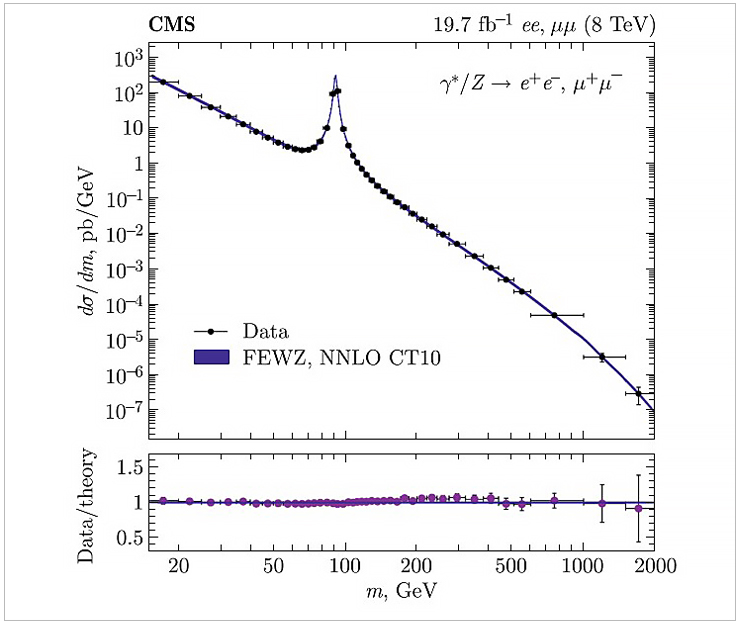 Fig. 3. The Drell-Yan differential cross section 1/σZ dσ/dm as measured in the combined dilepton channel (e+e− and μ+μ−). The ratio of experimental data and CM predictions in NNLO QCD and NLO EW is given. Calculations are made in FEWZ3.1 with PDF CT10
Fig. 3. The Drell-Yan differential cross section 1/σZ dσ/dm as measured in the combined dilepton channel (e+e− and μ+μ−). The ratio of experimental data and CM predictions in NNLO QCD and NLO EW is given. Calculations are made in FEWZ3.1 with PDF CT10
In 2010 – 2021, a series of experiments was performed with the LHC RUN1 and LHC RUN2 data at √s = 7, 8, and 13 TeV to search for new physics predicted by theories with an extended gauge sector, multidimensional gravity models, scenarios with candidates for dark matter particles. In addition, specialists tested the lepton flavour universality and carried out a number of other studies. So far, scientists have not observed any significant signs of new phenomena at high dilepton masses. The absence of a signal nevertheless tells researchers a lot about potential physics beyond the Standard Model. With data obtained at the CMS facility, scientists have set the strongest constraints to date on the masses of possible new particles that could decay into two leptons from a variety of models (Fig. 4). Stringent constraints have been also set on the parameters of models that predict non-resonant excesses at high mass, such as specific models with extra dimensions or models with a new contact interaction between particles.
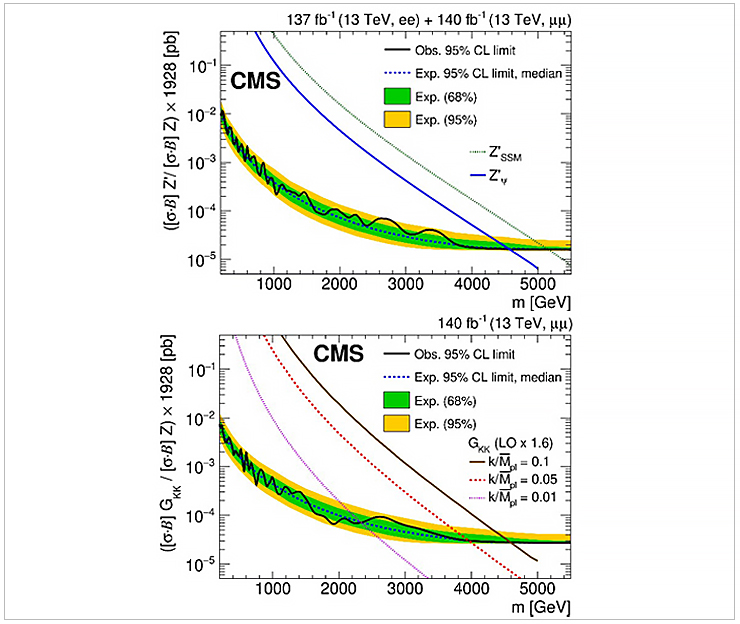 Fig. 4. The upper model-independent limits at 95% CL on the cross-section of muon pair production (black solid line) normalized to the Z0 boson production cross-section for new resonances with spin 1 and spin 2. The dotted line corresponds to the expected limit in the case of the SM (based on modelling). The shaded bands correspond to the 68 and 95% standard deviations. In addition, theoretical predictions are also given for the cross sections of the production of new gauge bosons (SSM and Z’ψ models) and the KK-state of the graviton for different couplings in scenarios of multidimensional gravity RS1
Fig. 4. The upper model-independent limits at 95% CL on the cross-section of muon pair production (black solid line) normalized to the Z0 boson production cross-section for new resonances with spin 1 and spin 2. The dotted line corresponds to the expected limit in the case of the SM (based on modelling). The shaded bands correspond to the 68 and 95% standard deviations. In addition, theoretical predictions are also given for the cross sections of the production of new gauge bosons (SSM and Z’ψ models) and the KK-state of the graviton for different couplings in scenarios of multidimensional gravity RS1
